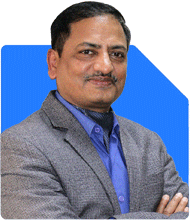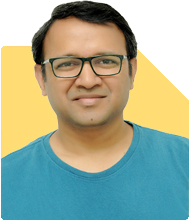Ramalingam Kalirajan |10031 Answers |Ask -Follow
Mutual Funds, Financial Planning Expert - Answered on Jul 03, 2024
He has an MBA in finance from the University of Madras and is a certified financial planner.
He is the director and chief financial planner at Holistic Investment, a Chennai-based firm that offers financial planning and wealth management advice.... more

Hello Sir - I am planning to open a minor account for my daughter in Zerodha with a 1 L corpus. Please advise what is the best way to invest this money in MF's or stocks. This is for long term. Thanks and Regards.
Mutual Funds: A Versatile Investment Option
Mutual funds are ideal for long-term investments. They pool money from multiple investors to invest in a diversified portfolio of stocks, bonds, and other securities. Let’s explore why mutual funds can be a great choice:
Advantages of Mutual Funds
Professional Management: Certified fund managers handle mutual funds. They have the expertise to make investment decisions on your behalf. This can lead to better returns compared to individual stock picking.
Diversification: Mutual funds invest in a variety of securities. This diversification reduces risk since your investment is not dependent on the performance of a single stock.
Liquidity: Mutual funds can be easily bought or sold, providing flexibility. However, it’s best to stay invested for the long term to realize significant gains.
Affordability: You can start investing in mutual funds with small amounts. This feature is perfect for building wealth over time through systematic investment plans (SIPs).
Tax Efficiency: Long-term capital gains from equity mutual funds are taxed at a favorable rate of 10% for gains over Rs 1 lakh per year. This can be beneficial for long-term investors.
Types of Mutual Funds
Equity Funds: These invest in stocks and have the potential for high returns. They are suitable for long-term goals but come with higher risk. For your daughter, equity funds can provide significant growth over the years.
Debt Funds: These invest in fixed-income securities like bonds. They are less risky but offer lower returns compared to equity funds. They can be part of a balanced portfolio to reduce overall risk.
Hybrid Funds: These funds invest in a mix of equities and debt. They offer a balance between risk and return. Hybrid funds can be a good option if you seek moderate growth with some stability.
Thematic and Sector Funds: These invest in specific sectors like technology or healthcare. They can provide high returns but come with increased risk. They are suitable for investors who understand the sector well.
Power of Compounding
One of the greatest advantages of investing in mutual funds for the long term is the power of compounding. By reinvesting your returns, your investment grows exponentially over time. This compounding effect can significantly increase your wealth if you start early and stay invested for a long period.
Active vs. Passive Funds
While passive funds like index funds are popular, they track a market index and do not aim to outperform it. Actively managed funds, on the other hand, have the potential to generate higher returns as fund managers actively select and manage the fund’s portfolio. Given that you seek growth, actively managed funds might be more suitable for achieving higher returns.
Disadvantages of Direct Platforms
Many investors consider using direct platforms for investing in mutual funds. However, these platforms often lack personalized investment guidance. They recently faced issues with same-day NAV allocation, which can be frustrating. Moreover, the absence of a dedicated advisor means you miss out on expert advice for tailoring your investment strategy to your goals.
Why Regular Funds through a Certified Financial Planner (CFP)?
Investing in regular funds through a Mutual Fund Distributor (MFD) with CFP credentials can provide valuable benefits:
Personalized Advice: A CFP can help you select the right funds based on your financial goals and risk appetite. They offer expert guidance tailored to your unique situation.
Ongoing Support: With a CFP, you get continuous support and advice. They can assist you with rebalancing your portfolio, tax planning, and navigating market changes.
Convenience: Investing through a CFP ensures your investment process is smooth and hassle-free. They handle all the paperwork and administrative tasks for you.
Stock Investments: High Potential, Higher Risk
Investing in stocks can offer substantial returns, but it comes with higher risks. Here’s a closer look at the pros and cons of stock investments:
Advantages of Stock Investments
High Return Potential: Stocks have historically provided higher returns compared to other asset classes. Investing in the right companies can lead to significant wealth creation.
Ownership in Companies: By buying stocks, you own a part of the company. This ownership can bring dividends and capital appreciation as the company grows.
Liquidity: Stocks can be easily bought and sold on the stock market. This liquidity allows you to quickly access your funds if needed.
Disadvantages of Stock Investments
Volatility: Stock prices can be highly volatile. Market fluctuations can lead to significant short-term losses, which might be challenging to manage emotionally.
Requires Knowledge and Research: Successful stock investing demands thorough research and understanding of the market. It’s time-consuming and requires a good grasp of financial principles.
Risk of Loss: There’s always a risk of losing your entire investment in stocks, especially if the company performs poorly or the market crashes.
Long-term Perspective
For your daughter’s long-term financial goals, stocks can be a part of the portfolio, but it’s crucial to approach with caution. Diversification and selecting fundamentally strong companies can mitigate risks.
Combining Mutual Funds and Stocks
A balanced approach can be to invest in both mutual funds and stocks. Here’s how you can do it:
Core-Satellite Strategy
Core Portfolio: Allocate a significant portion of your investment to mutual funds. This core portfolio will provide stability and long-term growth through professional management and diversification.
Satellite Portfolio: Use a smaller portion for direct stock investments. This satellite portfolio can aim for higher returns by investing in selected stocks based on your research and risk appetite.
Systematic Investment Plan (SIP)
Consider starting a SIP for the mutual funds portion. SIPs allow you to invest a fixed amount regularly, averaging out market volatility and compounding your returns over time. They are a disciplined way to build wealth gradually.
Investing through direct digital platforms like Zerodha has become increasingly popular due to their low-cost structure and ease of access. However, there are several challenges associated with these platforms, particularly when it comes to long-term investments like those for your daughter. Here’s a detailed look into these challenges and why investing through a Mutual Fund Distributor (MFD) with Certified Financial Planner (CFP) credentials can be a better option.
Challenges in Investing through Direct Digital Platforms
Limited Investment Guidance
Lack of Personalized Advice: Direct platforms typically provide a vast array of funds and stocks but little to no guidance on which to choose. For novice investors or those without deep financial knowledge, this can be overwhelming and confusing.
No Tailored Strategies: Every investor has unique financial goals and risk tolerances. Direct platforms often lack the ability to tailor investment strategies to individual needs. This gap can lead to suboptimal investment decisions that might not align with your long-term goals.
Absence of Professional Support: While direct platforms might have basic customer support, they generally don’t offer professional financial advice. This absence can be a significant drawback when it comes to making informed investment decisions and managing your portfolio effectively.
Operational Issues
Same-Day NAV Allocation Issues: Recently, direct platforms like Zerodha have faced problems with same-day NAV (Net Asset Value) allocation. This issue can affect the timing of your investments and redemptions, potentially leading to unexpected outcomes or missed opportunities. For instance, if you place an order expecting it to be executed at the NAV of that day but it gets delayed, you might end up buying or selling at a different price than intended.
System Downtimes and Delays: Like any digital platform, direct investment portals can experience technical glitches or downtimes. These interruptions can prevent you from executing trades or accessing your account when needed. This is particularly concerning during volatile market conditions when timely decisions are crucial.
Complexity and Lack of Support
Navigating the Platform: Although digital platforms are user-friendly, they can still be complex for those not well-versed in investment jargon or processes. This complexity can deter new investors from making confident decisions or fully understanding their investments.
DIY Approach: Direct platforms encourage a do-it-yourself (DIY) approach to investing. While this empowers investors to take control, it also means they need to stay updated on market trends, fund performance, and economic indicators. This continuous monitoring and decision-making can be time-consuming and stressful.
No Investment Education: Direct platforms rarely offer in-depth educational resources or training for investors. This lack of educational support can lead to poor investment choices and missed opportunities for portfolio optimization.
Transactional Focus
Focus on Buying and Selling: Direct platforms are primarily designed for executing transactions. They excel in helping users buy or sell mutual funds and stocks but often do not emphasize portfolio management or long-term financial planning. This transactional focus can result in a fragmented approach to investing without a coherent strategy.
Insufficient After-Sales Service: Post-purchase support is limited on direct platforms. If you encounter issues with your investments or need advice on portfolio rebalancing, you may find it challenging to get the help you need.
Benefits of Investing through a Mutual Fund Distributor (MFD) with CFP
Given the challenges associated with direct platforms, working with an MFD who is also a Certified Financial Planner (CFP) can offer significant advantages:
Comprehensive Financial Planning
Holistic Approach: A CFP takes a holistic view of your financial situation. They consider your income, expenses, risk tolerance, and future goals to create a comprehensive investment plan. This approach ensures that your investments align with your overall financial strategy.
Goal-Based Planning: CFPs help you define and prioritize your financial goals. Whether it’s saving for your daughter’s education or planning for retirement, they design investment strategies that cater to these specific objectives.
Regular Review and Adjustment: Markets and personal circumstances change over time. A CFP regularly reviews your portfolio and makes necessary adjustments to keep you on track towards your goals. This dynamic management helps optimize your returns and mitigate risks.
Personalized Advice and Support
Customized Fund Selection: Based on your risk profile and financial goals, a CFP recommends funds that best suit your needs. This personalized advice can lead to better fund selection compared to picking funds on your own through a direct platform.
Ongoing Support and Guidance: Unlike direct platforms, an MFD with CFP credentials provides continuous support. They offer advice on when to buy, hold, or sell investments and guide you through market ups and downs.
Educational Insights: CFPs educate you about different investment options and strategies. This empowerment helps you make informed decisions and feel confident about your financial future.
Efficient and Hassle-Free Process
Streamlined Processes: Working with an MFD means they handle the administrative tasks for you. From account opening to fund transfers, they ensure a seamless and hassle-free experience.
Access to Expert Tools and Resources: MFDs often have access to advanced tools and resources for portfolio analysis and risk assessment. These tools provide deeper insights into your investments and help optimize your portfolio.
Peace of Mind: Knowing that a professional is managing your investments gives you peace of mind. You can focus on your personal and professional life without constantly worrying about your portfolio.
Superior Returns Potential
Active Fund Management: MFDs typically recommend actively managed funds that aim to outperform market indices. These funds, managed by experienced professionals, can potentially offer higher returns compared to passively managed index funds available on direct platforms.
Risk Management: A CFP’s expertise in risk assessment helps protect your portfolio from market volatility. They diversify your investments across asset classes to reduce risk and enhance returns.
Long-Term Focus: CFPs emphasize long-term wealth creation. They discourage impulsive decisions based on short-term market movements and keep you focused on achieving your financial goals.
Making the Right Choice for Your Daughter’s Future
Investing Rs 1 lakh for your daughter’s future is a significant decision. While direct digital platforms like Zerodha offer convenience and low costs, they come with limitations that might not align with your long-term investment goals. The challenges of limited guidance, operational issues, and a transactional focus can impact your investment experience and outcomes.
On the other hand, investing through an MFD with CFP credentials provides personalized advice, comprehensive financial planning, and ongoing support. This professional approach ensures that your investments are tailored to your needs and managed effectively over time. By choosing to work with a CFP, you gain access to expert guidance, superior fund selection, and a stress-free investment process.
Your daughter’s future deserves the best financial planning and investment strategy. By making informed choices and leveraging professional expertise, you can build a robust portfolio that grows with her and supports her dreams.
Best Regards,
K. Ramalingam, MBA, CFP,
Chief Financial Planner,
www.holisticinvestment.in
You may like to see similar questions and answers below
Omkeshwar Singh | Answer |Ask -Follow
Head, Rank MF - Answered on Mar 17, 2020
Sanjeev Govila | Answer |Ask -Follow
Financial Planner - Answered on Feb 06, 2024
Ulhas Joshi | Answer |Ask -Follow
Mutual Fund Expert - Answered on Mar 27, 2024
Dr Nagarajan J S K |2120 Answers |Ask -Follow
NEET, Medical, Pharmacy Careers - Answered on Aug 01, 2025
Nayagam P P |9775 Answers |Ask -Follow
Career Counsellor - Answered on Aug 01, 2025
Dr Nagarajan J S K |2120 Answers |Ask -Follow
NEET, Medical, Pharmacy Careers - Answered on Aug 01, 2025
Dr Nagarajan J S K |2120 Answers |Ask -Follow
NEET, Medical, Pharmacy Careers - Answered on Aug 01, 2025
Dr Nagarajan J S K |2120 Answers |Ask -Follow
NEET, Medical, Pharmacy Careers - Answered on Aug 01, 2025
Nayagam P P |9775 Answers |Ask -Follow
Career Counsellor - Answered on Aug 01, 2025
Ramalingam Kalirajan |10031 Answers |Ask -Follow
Mutual Funds, Financial Planning Expert - Answered on Aug 01, 2025
Radheshyam Zanwar |6049 Answers |Ask -Follow
MHT-CET, IIT-JEE, NEET-UG Expert - Answered on Aug 01, 2025
Ramalingam Kalirajan |10031 Answers |Ask -Follow
Mutual Funds, Financial Planning Expert - Answered on Aug 01, 2025
Patrick Dsouza |1351 Answers |Ask -Follow
CAT, XAT, CMAT, CET Expert - Answered on Aug 01, 2025























